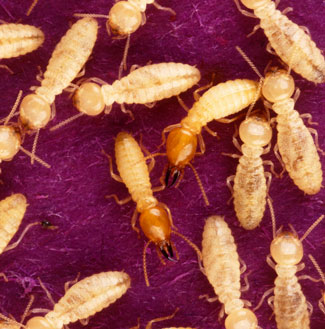What Are the Signs of Termites?
By Chris Williams on April 7, 2015.
 If a homeowner thinks they see some signs of termites, the first thing we do is recommend a professional inspection by a trained, licensed pest control expert. An exterminator knows what to look for and where to look. Subterranean termite damage to wood can look very much like the damage from some other pests such as carpenter ants, or even wood rot. A pro can tell the difference, saving you worry and money for unnecessary treatment or repairs.
If a homeowner thinks they see some signs of termites, the first thing we do is recommend a professional inspection by a trained, licensed pest control expert. An exterminator knows what to look for and where to look. Subterranean termite damage to wood can look very much like the damage from some other pests such as carpenter ants, or even wood rot. A pro can tell the difference, saving you worry and money for unnecessary treatment or repairs.
However, if you are determined to self-diagnose your problem, here are some tips to help determine whether or not you have subterranean termites. This is not a complete inspection list; an inspector would do much more.
What Am I Looking For?
You are looking for dead swarmer termites or their shed wings (see Are Those Swarmer Termites?), termite mud tubes (see What Do Termite Tubes Look Like?), or termite damage (see What Does Termite Damage Look Like?). You will only find the actual worker termites if you break open active mud tubes or infested wood.
The most commonly infested sites are wherever there is wood-soil contact, exterior walls, near cracked foundations, sill plates and joists, walls next to garages, areas near porches, window frames, basement walls, and places where moisture has built up or wood has been wet from leaky roofs, plumbing leaks, or condensation. Foundation walls that are hollow-block construction are especially susceptible to termite entry, as are dirt-filled porches.
How Do I Find Termite Damage?
Grab a flashlight and a flat blade screwdriver. Wood can be heavily damaged by termites on the inside and still look relatively normal on the surface. Use a hammer to tap suspect wood parallel to the grain with a screwdriver. If the wood has been damaged, the blade of the screwdriver will penetrate the wood. Tap or sound the wood with the handle end of the screwdriver and listen for hollow or dull sounds that could indicate damaged wood.
To find termite damage, pay special attention to the susceptible sites mentioned above, and do the following:
- Look for ripples in wallboard or paneling
- Look for tiny holes in drywall or wallpaper
- Look for raised paint or wallpaper, indicating damage beneath
- Look for cracks in baseboards which could indicate excessive moisture or termite feeding damage
- Probe sill plates and joists with the screwdriver every foot in distance
- Pry back baseboards and window/door trim boards if damage is suspected beneath
- Check for structural sagging, buckling, or settling
- Check plumbing and utility fixture entrances through the basement floor and foundation
- Check areas where there have been water leaks or where water stains are seen
[Source: Subterranean Termites: A Handbook for Homeowners, University of Nebraska Extension]
Photo credit: USDAgov / Foter / CC BY